Author: Daii
Since Trump took office, the cryptocurrency market has become the "policy market" of the United States. These days, the price of Bitcoin has been jumping up and down between Trump's words and actions. It reached a high of $95,000 and almost fell below $80,000 at the lowest.
This violent price fluctuation will undoubtedly make investors nervous. Some may feel excited and chase the thrill of short-term speculation, while others may feel anxious, worrying that their assets will shrink in an instant. However, as we will explore in depth, this seemingly erratic price volatility is the most authentic portrayal and vivid embodiment of the emerging phenomenon of "crypto-capitalism".
Cryptocurrencies are not only a technological innovation, but also a digital mirror that reflects human nature, with greed and fear intertwined. Every rise and fall in price is like a ripple on this mirror, reflecting the complex and subtle mentality of the participants.
There are two pieces of good news to tell you about market trends. One is the US PMI (Purchasing Managers' Index), which has been above 50 for 2 months (January and February 2025) after 26 consecutive months of contraction, indicating that the economy is starting to recover. Research shows that this indicator has accurately predicted every economic turning point for the past 14 years.
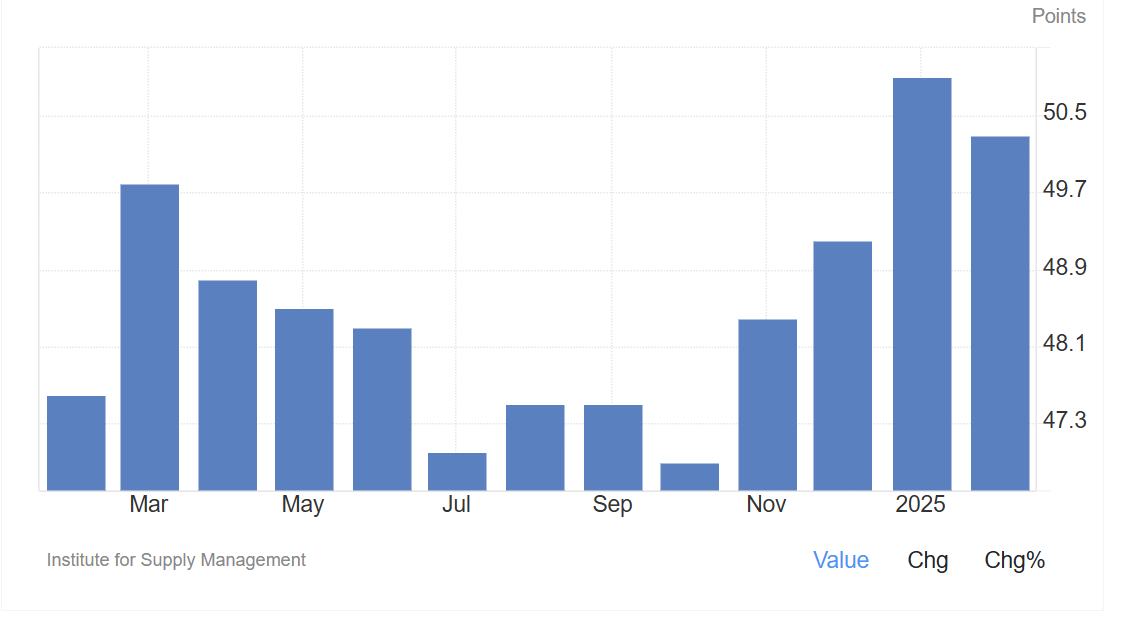
The other good news is that global M2 has started to surge since 2025 (see the chart below). Research by Real Vision shows that Bitcoin prices lag global M2 changes by about 10 weeks.
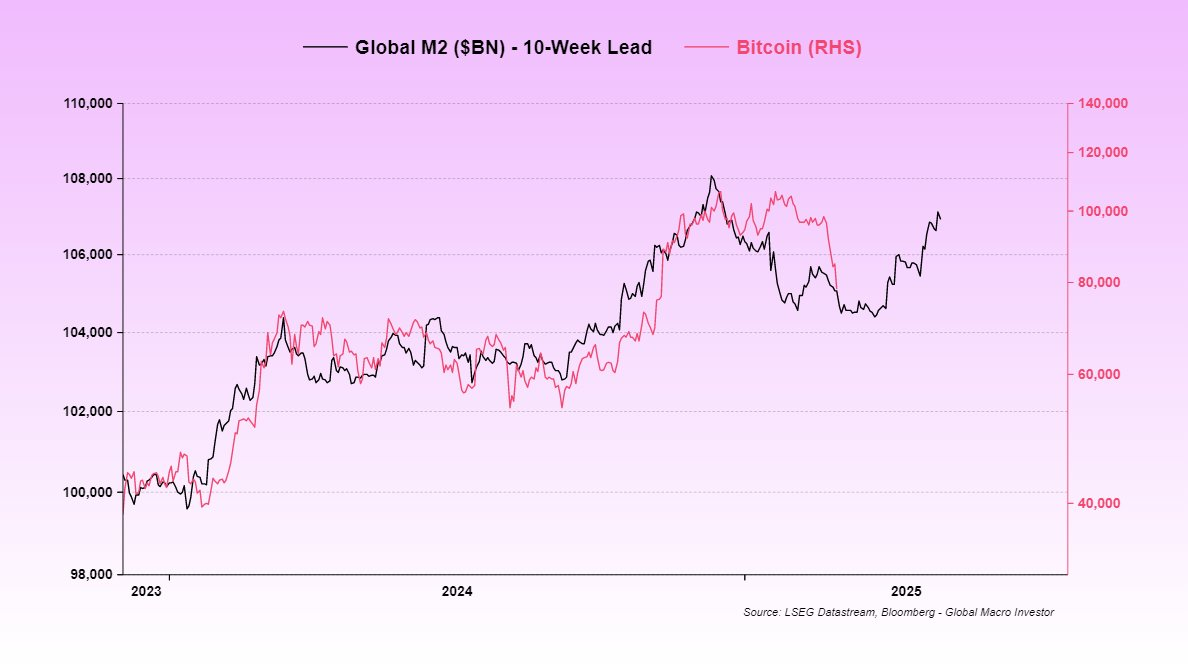
Analyst Lyn Alden also points out that within any 12-month time frame, Bitcoin follows the direction of global liquidity (M2) 83% of the time, a higher correlation than any other major asset class.
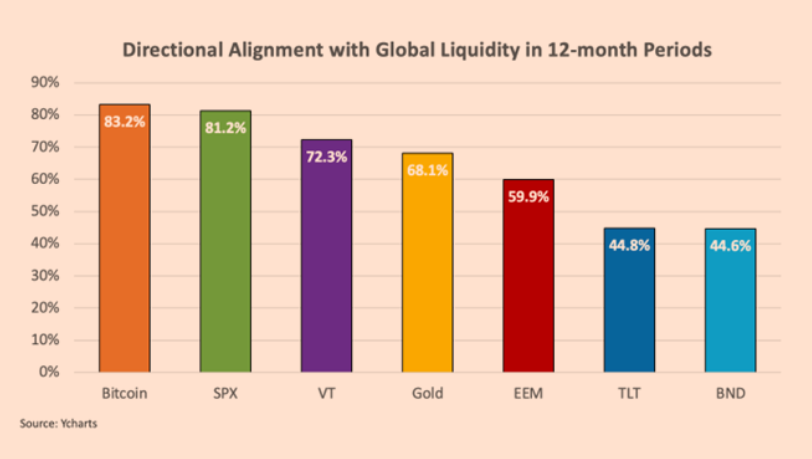
Whether it's PMI or M2, they both tell you from a fundamental perspective that Bitcoin's good days are not far away. But never forget that the decision-making power over Bitcoin's price lies not in the fundamentals, but in the centralized exchanges. If you still have doubts about this, I suggest you read this article.
In fact, if you truly believe in Bitcoin's long-term value and have confidence in the underlying technical logic and future potential, then the short-term price fluctuations are like the waves on the surface of the sea - although there are ups and downs, they will eventually calm down, and there is no need to worry or panic. The only thing you need to do is control your own desires and not leverage too much.
Now, let's start today's main topic - crypto-capitalism.
In the 17th century, the Dutch used tulip bulbs to exchange entire streets of real estate, in the 19th century the American West saw a frenzy of gold rushers and outlaws dancing together, and in the 21st century we face flickering candlestick charts, writing a new scripture of digital wealth on the blockchain. Crypto-capitalism is not just a technological revolution, but a digital mirror of human greed and fear - it packages the uncertainty of human nature with the certainty of mathematics, making every participant both the god and the gambler of their own wealth script.
In this algorithmically constructed new world, Bitcoin is just the first tip of the iceberg to emerge. The real drama lies in the fact that as financial sovereignty shifts from central banks to distributed ledgers, and the value of labor is redefined by hash power, we are witnessing the craziest evolutionary form of capitalism.
Crypto-capitalism is like Pandora's box opened, with wealth and risk following closely. Once this box is opened, it can never be closed again. There are no central bank governors here, only tireless smart contracts; no roaring factories, only the wealth aria of mining rigs.
Today, let's dive in and see what kind of wealth game "crypto-capitalism" is, and whether there are still opportunities for you and me.
1. What is Crypto-capitalism?
Imagine if there was a currency that didn't belong to any country, wasn't controlled by any bank, but simply existed based on the code and consensus on the internet - would you think this is a fantasy?
Bitcoin is precisely such a disruptive digital currency.
In 2009, Bitcoin emerged, ushering in the era of cryptocurrencies. This new type of "cryptocurrency" asset is not issued by a central bank, but operates through cryptography and distributed ledger technology (blockchain). Bitcoin is like digital gold, with a limited supply, generated through complex calculations (mining), and freely circulating in a decentralized network.
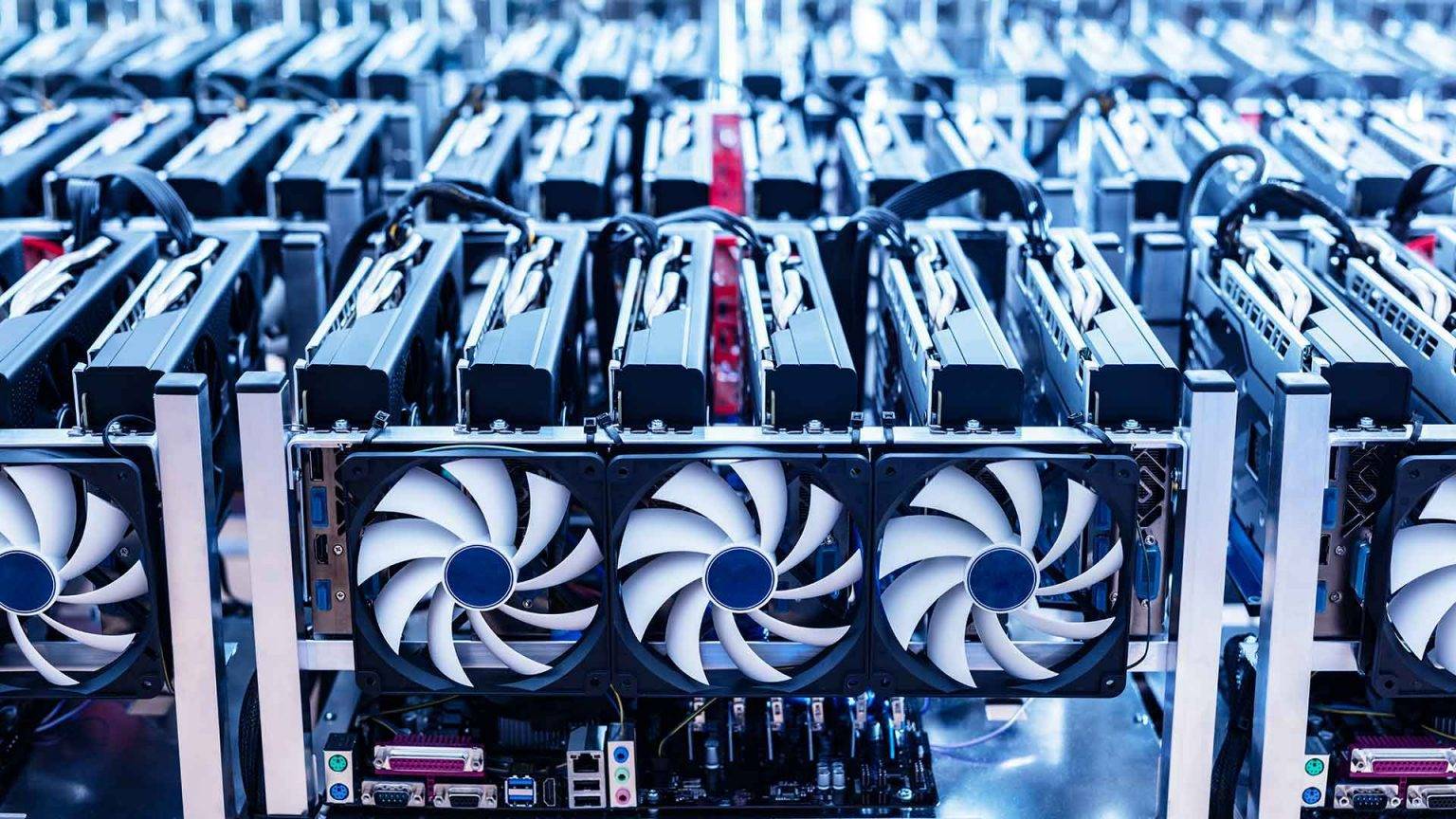
Crypto-capitalism, represented by Bitcoin and other cryptocurrencies, is a new financial system and economic phenomenon. Simply put, it refers to the capitalist form centered around cryptocurrencies. In this system, the accumulation, growth and distribution of wealth all revolve around cryptocurrencies, with both similarities and significant differences from traditional capitalism.
Unlike traditional capitalism where factories, land, stocks, etc. are forms of capital, the core of crypto-capitalism is the digital tokens themselves. These digital tokens, such as Bitcoin and Ethereum, are no longer just payment tools, but have become carriers of value storage and appreciation. Their value is driven entirely by market supply and demand and the consensus of participants, rather than government credit backing.
This means that anyone who owns cryptocurrencies is like owning "land" or "gold" in the digital age, and has the opportunity to share in the dividends of the digital economy. Crypto-capitalism breaks down the barriers of the traditional financial system, making the process of wealth creation and accumulation more direct and decentralized.
However, like the two sides of a coin, crypto-capitalism, while presenting great opportunities, also has an inherently asymmetric nature. It is destined not to be a "utopia" where everyone is equally wealthy, but more like a "gold rush" feast for the few.
2. What is Asymmetric Wealth Opportunity?
To understand the "asymmetry" of crypto-capitalism, we first need to understand what "asymmetric wealth opportunity" means.
Simply put, asymmetric wealth opportunity refers to a wealth distribution pattern where, during a certain period of economic or technological change, a small number of people can use information, technology or first-mover advantages to accumulate wealth at a rate far exceeding the average person, while the vast majority may suffer losses.
This "asymmetry" is not unique to cryptocurrencies, but has accompanied every major technological revolution and industrial change in history. For example:
During the Industrial Revolution, factory owners and entrepreneurs who were the first to master new technologies like the steam engine and textile machines became the tycoons of the era, quickly amassing huge fortunes, while the vast working class faced exploitation and poverty in the early stages.
During the Internet revolution, the earliest Internet entrepreneurs and venture capitalists, such as Bill Gates and Jeff Bezos, also became the new wealth giants, while most people were just users of the Internet.

The core features of asymmetric wealth opportunity are "winner-take-all" and "first-mover advantage".
In the early stages of a transformation, information and resources are often concentrated in the hands of a few, who, with keen insight and proactive action, seize the opportunity and build powerful competitive advantages, thus dominating the new wealth distribution pattern. Latecomers, due to lagging information and scarce resources, can only passively accept the rules of the game, and may even become "bag holders".
Here is the English translation:The emergence of cryptocurrencies has once again created a typical "asymmetric wealth opportunity". Bitcoin has transformed from an "obscure code" to "digital gold", filled with information divides and cognitive biases.
Those who recognized the value of cryptocurrencies early on and dared to take the risk to invest, were like Columbus discovering the New World, taking the lead in occupying the wealth frontier. When the concept of cryptocurrencies became widely known to the public and the prices skyrocketed, the "latecomers" rushed into the market, often only able to fight for the remaining "gold dust" in the crowded "mining field", and sometimes even ended up with "mining slag".
3. Why is crypto-capitalism an asymmetric wealth opportunity?
This is partly due to the inherent characteristics of cryptocurrencies, and partly due to the development stage of the crypto market.
3.1 Early bird bonus is huge
The Genesis Block of Bitcoin was born in 2009, initially with almost no value, where $1 could buy hundreds or even thousands of Bitcoins. Only a small number of cryptography enthusiasts and tech geeks believed in the future of this "air coin". These people became the "first pioneers" of crypto-capitalism.
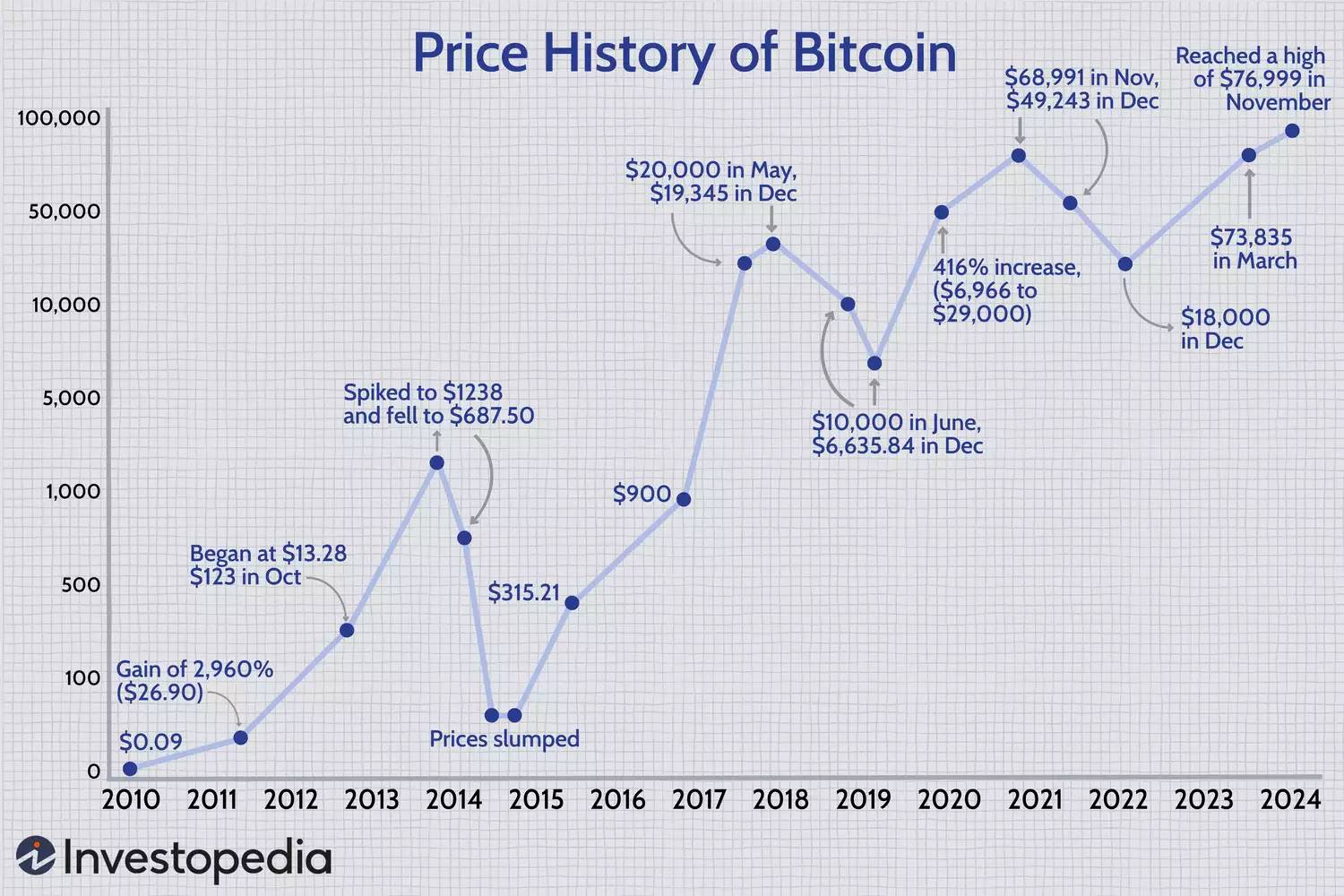
Norwegian man Christopher Koch spent $27 in 2009 to purchase 5,000 Bitcoins. At the time, this investment was almost negligible. However, years later, when the price of Bitcoin skyrocketed, he realized that this "inadvertent" investment was now worth nearly $1 million!
There is also the story of "Bitcoin Pizza Day", where programmer Laszlo Hanyecz used 10,000 Bitcoins to buy two pizzas. At the time, 10,000 Bitcoins were worth only $41, but now those Bitcoins are worth hundreds of millions of dollars!
These seemingly "overnight success" stories are not fictional, but real experiences of early cryptocurrency participants. They merely recognized and accepted Bitcoin earlier than others, and thus obtained unimaginable wealth returns for ordinary people. This "early bird bonus" is amplified infinitely in the cryptocurrency field.
As the famous investment quote goes: "The secret of investing is not in running fast, but in standing early." In the game of crypto-capitalism, this saying is particularly apt.
3.2 The "unearned income" effect is powerful
It is the "coin-based" wealth growth model that allows the cryptocurrency market to generate returns on capital much faster than "labor-based wealth".
In the traditional economy, the accumulation of wealth mainly relies on creating value through labor, and then achieving appreciation through investment and operation. However, the cryptocurrency market presents a completely different picture.
Holding cryptocurrencies itself has become a major "way to make money".
Imagine an ordinary office worker, who works hard for a year, and their salary may only grow by 5%-10%, while the interest on their bank deposits is negligible.
However, the price of Bitcoin could double, triple, or even more in a year or even a few months! In 2017, Bitcoin soared from less than $1,000 at the beginning of the year to nearly $20,000 by the end of the year, a gain of over 20 times! At the end of 2020, Bitcoin started a new bull market, rising from around $20,000 to nearly $69,000 in November 2021, a gain of over 3 times! Although Bitcoin has fallen from its peak of around $110,000, it is still over $80,000.
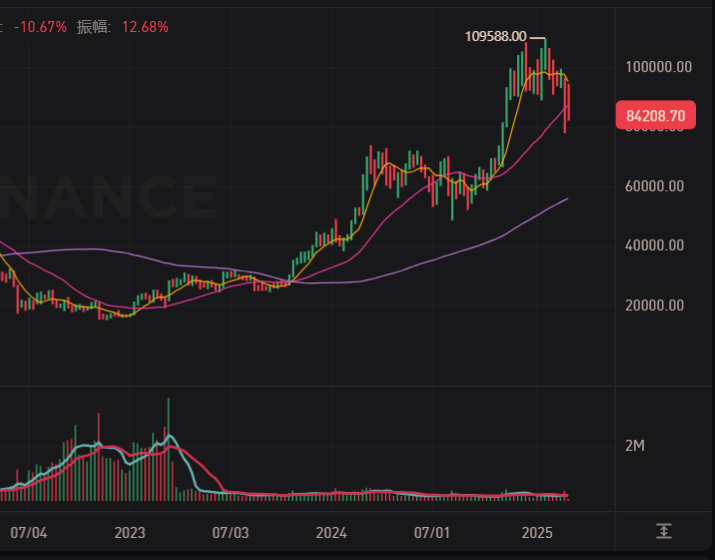
For those holding Bitcoins, their wealth has expanded rapidly just by "holding" it. While those who did not hold cryptocurrencies, no matter how diligently they work, their wealth growth rate is difficult to match. This speed difference in "capital returns" has made the wealth distribution in crypto-capitalism even more asymmetric.
The "coin-based" wealth growth model makes it easier for holders of crypto assets to achieve financial freedom, while ordinary workers appear to be "working hard for little reward".
3.3 Severe polarization
It is the "volatility" and "risk" of the cryptocurrency market that have amplified the polarization of wealth distribution.
The cryptocurrency market is like a free competition arena without "traffic lights", with violent price fluctuations and rapid bull-bear market shifts. This high volatility brings the possibility of "overnight wealth", but also the risk of "instant zero".
When the market is in a bull market, early holders and "whales" (investors holding large amounts of cryptocurrencies) are the biggest beneficiaries. They can profit through high buying and low selling, or simply by holding. When the market turns bearish, those "retail investors" who chased the highs often become the biggest victims. They may helplessly watch their assets shrink significantly, or even lose everything, like those investors who couldn't control their greed and used leverage.
At the end of 2021, the price of Bitcoin reached a historical peak, attracting countless "latecomers" to rush into the market. However, the good times did not last long. In 2022, the cryptocurrency market experienced a "big crash", with Bitcoin plummeting nearly 80%, and other cryptocurrencies like Ethereum also halving in value. Countless investors who bought at the highs saw their assets shrink significantly, and even had to liquidate their positions.
According to statistics, the entire cryptocurrency market capitalization evaporated $2 trillion in 2022! One can imagine how much of that was the hard-earned money of ordinary investors.
The volatility of the cryptocurrency market is like a "double-edged sword". It can allow early entrants to quickly accumulate wealth, but it can also instantly wipe out the wealth of late chasers.
This rapid switching between "heaven and hell" has further exacerbated the asymmetry of wealth distribution in crypto-capitalism.
3.4 Serious market manipulation
The information asymmetry and market manipulation in the cryptocurrency market make it harder for "latecomers" to share the pie.
Although the cryptocurrency market claims to be "decentralized", in reality, information and resources are still highly concentrated in the hands of a few. Early participants, project parties, exchanges, media, etc. often have more and timelier market information, and they can influence market sentiment and price trends through various means.
For example, some "project parties" may use false propaganda, pump-and-dump schemes, etc. to harvest the wealth of retail investors. Some "whales" can collude to manipulate the market, create "fake bull markets", lure retail investors to buy at high prices, and then cash out themselves. Ordinary investors, due to limited information channels and lack of professional knowledge, often find it difficult to distinguish the truth, and are more likely to become the "harvested" targets.
In the cryptocurrency market with information asymmetry and imperfect rules, the advantage of "being first to know and act" is further amplified, while "latecomers" are more likely to become the harvested objects. This inequality of information and resources has also led to an even more obvious "winner-takes-all" situation in the distribution of wealth in crypto-capitalism.
Finally, we use data to illustrate the asymmetry of crypto-capitalism.
Data from a blockchain data analysis company shows that nearly 93% of Bitcoins are held by less than 2% of addresses, and only 0.03% of addresses control over half (60.6%) of the total Bitcoins! Some analysts even point out that about 2,000 addresses hold 37.41% of the world's Bitcoins!
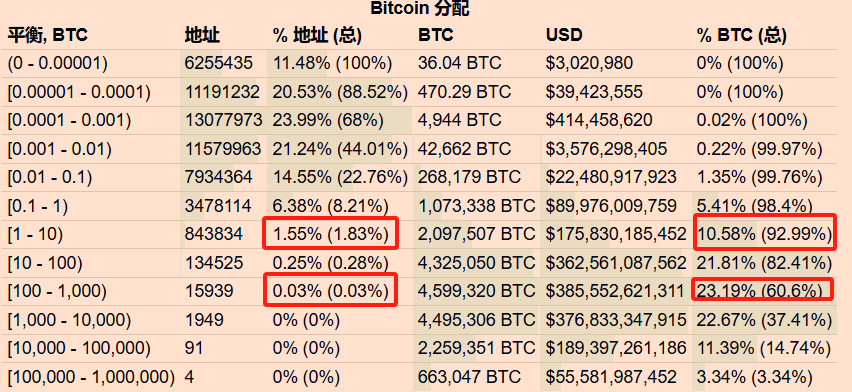
This degree of wealth concentration far exceeds that of traditional capitalist society!
Conclusion: By the campfire in the digital jungle, please hold your cognitive weapons tightly
The ultimate paradox of crypto-capitalism lies in the fact that it promises equality through decentralized technology, but amplifies inequality in a more cruel way; it breaks down the high walls of traditional finance, but builds new castles of computing power and information.
When we gaze at this 24-hour running wealth perpetual motion machine, what we really need to confront is not the fluctuations of the market, but the speculative instinct deeply rooted in human genes.
Remember, in this digital gold rush field without geographical boundaries, the greatest risk is not missing the opportunity to get rich, but forgetting the human cost behind the wealth. When everyone is talking about "financial freedom", the true freedom is not to grasp the code of wealth, but to remain independent after seeing through the rules of the game. Wealth may vanish with the loss of private keys, but the greed of human nature will exist forever on the blockchain - this is the most profound revelation that crypto-capitalism has left us.
In the crypto "casino", the most precious chips have never been Bitcoin, but the ability to think independently. When the fireworks of algorithmic revelry fade away, those who anchor their self-awareness in the digital flood will always be the ones who hold the true wealth.







